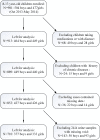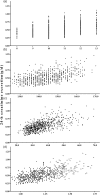Anthropometry-based 24-h urinary creatinine excretion reference for Chinese children
- PMID: 29791502
- PMCID: PMC5965866
- DOI: 10.1371/journal.pone.0197672
Anthropometry-based 24-h urinary creatinine excretion reference for Chinese children
Abstract
To establish 24-h urinary creatinine excretion reference ranges based on anthropometry in healthy Chinese children, a cross-sectional survey was conducted using twice-sampled 24-h urine and anthropometric variables. Age- and sex-specific 24-h creatinine excretion reference ranges (crude and related to individual anthropometric variables) were derived. During October 2013 and May 2014, urine samples were collected. Anthropometric variables were measured in the first survey. Data of 710 children (377 boys and 333 girls) aged 8-13 years who completed the study were analyzed. No significant difference was observed in 24-h urine volumes between the two samples (median [interquartile range): 855.0 [600.0-1272.0) mL vs. 900.0 [660.0-1220.0) mL, P = 0.277). The mean 24-h urine creatinine excretion was regarded as representative of absolute daily creatinine excretion in children. Sex-specific, body-weight-adjusted creatinine excretion reference values were 15.3 mg/kg/day (0.1353 mmol/kg/day) for boys and 14.3 mg/kg/day (0.1264 mmol/kg/day) for girls. Differences were significant between boys and girls within the same age group but not across different age groups within the same sex. Ideal 24-h creatinine excretion values for height were derived for potential determination of the creatinine height index. These data can serve as reference ranges to calculate ratios of analyte to creatinine. The creatinine height index can be used to assess somatic protein status.
Conflict of interest statement
The authors have declared that no competing interests exist.
Figures


References
-
- Borsook H, Dubnoff JW. The hydrolysis of phosphocreatine and the origin of urinary creatinine. J Biol Chem. 1947;168(2):493–510. - PubMed
-
- Bjornsson TD. Use of serum creatinine concentrations to determine renal function. Clin Pharmacokinet. 1979;4(3):200–22. - PubMed
-
- Heymsfield SB, Arteaga C, McManus C, Smith J, Moffitt S. Measurement of muscle mass in humans: validity of the 24-hour urinary creatinine method. Am J Clin Nutr. 1983;37(3):478–94. doi: 10.1093/ajcn/37.3.478 - DOI - PubMed
-
- Liappis N, Reimnitz P. Reference values of sodium, potassium, calcium, chloride and inorganic phosphate excretion in 24-hour urine of healthy children. Klin Padiatr. 1984;196(6):367–9. Epub 1 November 1984. doi: 10.1055/s-2008-1034097 - DOI - PubMed
-
- Remer T, Neubert A, Maser-Gluth C. Anthropometry-based reference values for 24-h urinary creatinine excretion during growth and their use in endocrine and nutritional research. Am J Clin Nutr. 2002;75(3):561–9. doi: 10.1093/ajcn/75.3.561 - DOI - PubMed
Publication types
MeSH terms
Substances
LinkOut - more resources
Full Text Sources
Other Literature Sources

